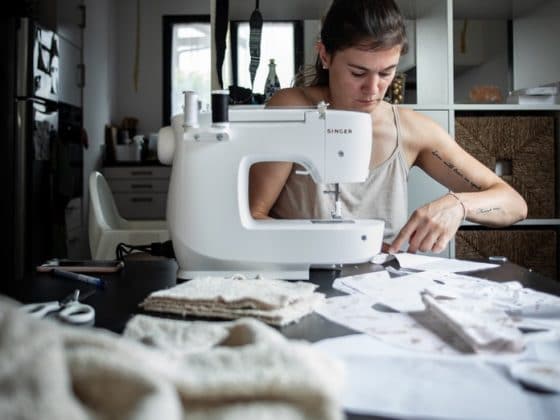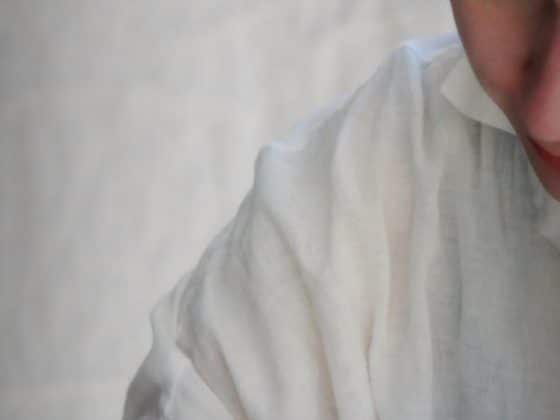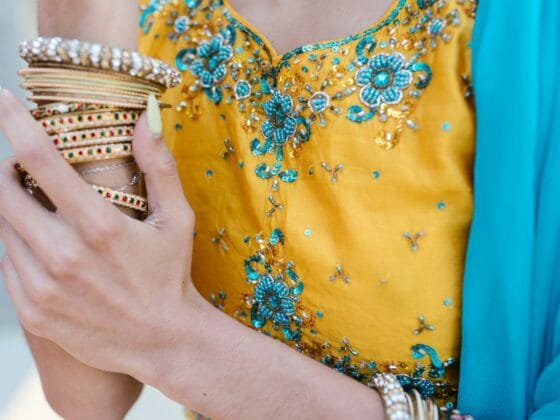Facing is generally a non-decorative fabric (it could be decorative, too) attached to an edge of a garment for support, cleanliness, or both. Facing provides structure by adding thickness to your garment’s edges, adding strength to seams, and preventing garments from stretching out of shape over time.
When the facing goes around a neckline, it is usually called a collar. It can also be applied to a sleeve hem or skirt waistband if no lining or seam allowance is already present in these areas. If you are making a lined jacket and want your lining to show when you wear it, this must be made from facing fabric visible from the outside of the coat when wearing it with its lining inside out.
We have put together a detailed guide for choosing your beginner sewing machine. Be sure to check it!
Table of Contents
- 1 What does facing do in sewing?
- 2 What are the different types of facing and interfacing?
- 3 What does stitch facing mean?
- 4 What is self-facing in sewing?
- 5 What is shaped facing?
- 6 What is decorative facing?
- 7 How to sew facing to bodice?
- 8 How are facing applied to different edges of the garments?
- 9 What’s the difference between knit and woven facings?
- 10 Conclusion
What does facing do in sewing?
The purpose of facing, especially in garment construction, is to finish the edge of the fabric. You may see this commonly seen on necks or armholes where you want a clean and finished look for your garment. Facing also helps reinforce high-stress areas, such as necklines and armholes.
Facing can be made from the same fabric, a different fabric (self-facing), or even interfaced with something like fusible fleece or batting (fusible and non-woven interfacings work very well). Once applied, stitches are sewn to affix each side to itself. If sewing by machine, I recommend setting your stitch length at 2mm if possible. It helps immensely when you’re trying to sew as close as possible to the edge.
Facing can be applied with either right or wrong sides together and easily turned right for a finished look. If using interfacing, I recommend matching it up with the facing so that you’re stitching through both pieces at once.
What are the different types of facing and interfacing?
There are many types of facings to choose from, depending on the fashion style of the garment you are creating and its function. Many garments require more than one type of facing to create a finished look. Below you will find descriptions of each facing and a brief list of the types of garments they should be used.
Types of facings
Fusible – Fusible web is an adhesive material that you can fuse to the wrong side of your fabric for added stability and body. You must use fusible interfacing on necklines, armholes, and curved areas such as roundness and princess seams.
Stitched – These facings are stitched to the right side of your garment and then turned over onto the wrong side for stitching in place, just like a regular seam. You can stitch these facings into different styles such as surplice (shawls), rounded, square, and others.
Self-faced – A self-facing is a facing that is the same fabric as your garment, which you fold over on itself and stitch down to create a finished look with no raw edges showing. It also provides stability at necklines and armholes where knit fabrics tend to stretch out and do not require fusible interfacing along the edges if used on curves.
Lapped – Lapped facings are used around waistlines, necklines, and armholes, so they stretch with the garment when you move. They are easy to stitch in place with your machine or serger.
Types of interfacing?
Interfacing is a material with two layers, one of the fibers and the other facing. They come in many different types and forms. There are so many variations of interfacing available today, but this article focuses on the basic ones.
Basic Interfacings
- Canvas,
- Fusible Fleece
- Hip Hugger™
- Lightweight Fusible Interfacings (such as Vilene™)
- Weft Insertion Fusible (Wel-Flex™)
- Woven Interfacings (such as Twill-Weave).
Types of Woven Interfacings:
- Gentle
- Heavy
- Permanent Press
- Terry Cloth.
What are the different types of fusible interfacings?
Fusible interfacing is a type of special material that is manufactured with heat-sensitive glue on one side. When the side comes in contact with an iron it will stick to other materials because the heat and pressure emitted by the iron will activate the glue; making them stick together.
Fusible interfacing is available in several forms: woven, non-woven, lightweight, cutaway, and sew-in. The most commonly used are the non-woven, but woven interfacing is also becoming popular.
When and why should you use them?
Non-woven interfacings add body and stability to garments; they can be sewn into the seam allowance or applied with heat. This is a good option for sheer fabrics because it will not leave any visible stitches. They are also good for draping, lingerie, and tucks in blouses.
Woven interfacings are stronger than non-woven ones but less flexible, so they are more suitable for waistbands, necklines, shoulder seams, cuffs, and sleeve hems. Woven interfacings are machine washable, proving useful when working with knits on children’s clothing. If you want to add support to a shirt or dress, keep skirts and pants in place, and provide body to fabric without stiffness, you should use fusible interfacing because it is user-friendly.
What does stitch facing mean?
Sewing facing gives the garment a more finished look. When you sew in a facing, it’s like putting in the hand-sewn hem on the inside of your clothes. Our bodies are not perfectly flat, especially when we sit or stand. It means that our clothes fit differently in different areas.
It is challenging to keep seams and edges from looking puckered or pulled at odd angles when they come into contact with our bodies.
However, when you finish them by stitching down (or “joining,” as some people call it), the seam line has less chance of showing through clothing and makes for a very professional look. It also flattens any puckers resulting from construction, so your seams will lie nice and flat against your body.
What is self-facing in sewing?
Self-facing is a method of sewing to apply facing fabric on the “wrong” side of the garment. This facing fabric will be applied to the edge and neckline before putting them together. The self-facing can then be folded and stitched into place, creating a neat finish at the front neckline and armholes.
Self-facing allows you to avoid adding facings under your arms or onto your neckline, as this saves time and creates a smoother finish. On very tight-fitting clothes, self-facings are especially useful as they don’t bulge out as regular facings would.
This method of self-facing is usually applied to tight-fitting garments like bodycon dresses, swimwear, and dance costumes.
What is shaped facing?
Shaped-facing is the opposite of flat facing. It’s easier to sew shaped facing because you can match the corners at the seams. The shaped facing prevents the edges from fraying, so your garment will have a much cleaner edge without any threads or fabric poking out. It evens out the bulk on the outside, so there are no bumps to be seen through your outer layer.
What is decorative facing?
The decorative facing is a type of visible stitching that appears outside your garment. It can be used to hide seams and raw edges or highlight decorative stitches. Decorative facings can be either machine-sewn or hand-sewn in place.
How is decorative facing typically used in sewing?
Decorative facings are usually attached with decorative topstitching, cover stitching, decorative machine embroidery, or by hemming around the facing. In some cases, decorative facings are exposed when you add a lining to your garment. In this case, you need to finish the edge so that it doesn’t unravel before you’re ready to attach your lining.
Decorative facing and decorative stitches
Decorative facing is a great way to highlight decorative stitching. For example, you can run decorative stitching on the edge of your garment and then sew decorative topstitching along the edge of the decorative stitch. It creates a cool contrasting design effect.
What do you need to do before adding decorative facing in sewing?
Before attaching decorative facings, you must decide which method to use: decorative topstitching, cover stitching, decoration with machine embroidery, or hemming.
Decorative topstitching usually requires that both the under and upper pieces of fabric be finished (for example, by clipping or serving to unravel) so that they won’t when exposed.
With decorative topstitching, you want the decorative stitching to look like it’s actually holding both sides together. When using decorative machine embroidery or hemming, only one side of the garment will need to be finished.
What are decorative facing materials?
You can use decorative fusible interfacing for your decorative facing, but it’s also possible to use regular fabric or lightweight ribbing if that’s what you have on hand. To attach the facing without sewing, try iron-on adhesive tape, which is easy to remove and won’t leave any residue.
If you’re running decorative stitches on the edge of your garment, you might consider using clear elastic as a decorative facing. It stretches over seams nicely and isn’t visible outside your garment.
Some decorative facing names
Some common decorative facings available on sewing patterns include neckline facing, neckbands, wristbands, and sleeve heads. For shirt-style garments, decorative neckline facings are a great way to finish the top edge of the piece of clothing without adding bulk underneath.
It is especially true if you’re putting on a collar or necktie over the finished edge. Decorative-faced waistbands can break up all those vertical seams at the hem of a skirt or dress, making them more attractive.
Decorative wristbands give sweaters and cardigans an even more casual look by making otherwise plain cuffs stand out as decorative details when working with knits.
Related: Find out how to transfer a sewing pattern
How to sew facing to bodice?
In making a garment, the first step is to make the bodice. When you sew a garment without facings, it won’t be easy to give hemline and curves smooth curves. In this case, you need to sew facing. Afterward, stitching on both sides of your fabric from shoulder line down until the hem edge of the clothes would create a clean finish for hemline and curve areas.
Facing can help you ease the sewing process and add finishing touches to garments that look more elegant and polished. There are two types of facing: full or partial, depending on how deep the garment’s edge goes or how far up from the waist level it starts. For example, if it starts from the neckline area going down to the lower waist, it is called full facing. At the same time, partial facing starts only from the waistline going up to the lower neckline.
The facing type determines whether you can skip stitching on the machine hemline or curve areas. However, the same steps are followed for cutting out fabric, making full or partial facing.
How are facing applied to different edges of the garments?
When working on a sewing project, specific steps must be taken for the garment’s look and feel to turn out perfect. One of these essential procedures is applying facing or facings if they are applied in multiples. Facing creates a smooth edge along the raw, unfinished seams of your garment.
It also stabilizes seam allowances at necklines, armholes, waistlines, and other places where you don’t want them to stretch out when worn or during laundering. Garments with attached facings are more polished than those without facings because they have an attractive border around the edges instead of serged-off edges that can look messy, depending on how well you serge.
Many different types of facings can be used when creating a garment. The two most common facing materials are knits and wovens, and both perform the same function; to make the raw edges of your garments look finished. It is important to note these differences to select the right facing for your project.
What’s the difference between knit and woven facings?
Knits and weaves (wovens) each behave differently from one others. Knit fabric was created specifically for making garments. Knitted fabrics have stretch, which enables them to fit more contoured areas around the body, including curves such as bustlines, hips, shoulders, and arms. In addition, because they contain index material, they also provide a soft, comfortable fit for the wearer.
Knits are used as facings on the armholes and necklines because these areas stretch along with the body when you move. In addition, since they have elastic fibers woven into them, they will stretch over curves and roundness without puckering or pulling and give an attractive border around each edge.
It is important to use a quality knit-facing material to hold its shape after laundering and stretches as needed to follow the contours of your body. Knit facings can be purchased as knit tricots, single knits (very fine), and double knits (medium weight). You can also purchase small amounts of knit fabric at your local fabric store to use as facings if you wish.
Woven fabrics do not stretch and only come in two weights: very light and medium to heavyweight. They are pressed into shape, adding crispness and stability at the seams of your garment, which provides a tailored look. Wovens can be used on necklines and armholes, but since they will add bulk to the seams, they are not recommended for use on body-shaping areas such as bustlines and hips.
Wovens come in a wide range of fabrics, from chiffons, georgettes, and silks to cotton prints, linen blends, and polyester satins. In addition to these popular choices, you can also purchase novelty weaves that will make your garment stand out.
Conclusion
One of the most important parts of any garment or project is assembling it correctly. It means you have to make sure that your seams are straight and either pressed open or back, depending on the material you add to your piece. Facing and interfacing are two different elements in sewing that allow for a clean look, whether exposed or hidden.












1 comment